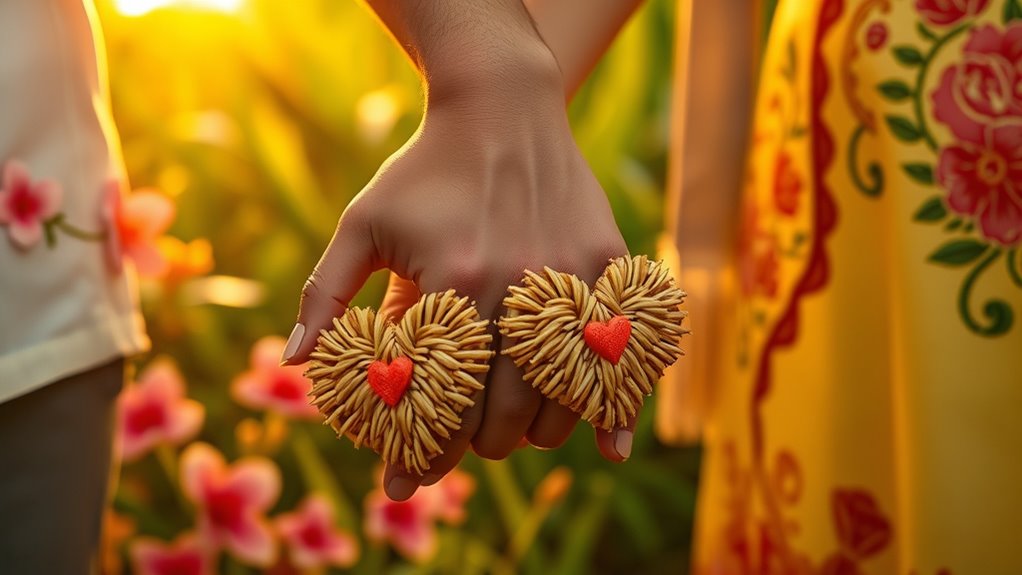In Filipino romance, “puso” symbolizes deep emotional connections and cultural values. It’s not just a word; it embodies love, care, and tradition. You’ll see it in romantic gestures, like serenades and shared meals, fostering closeness between partners. Puso also plays a key role in courtship and weddings, reflecting commitment and family ties. This cherished symbol shapes relationships, making them more meaningful. Discover how these traditions come to life as you explore further.
Key Takeaways
- Puso symbolizes community and affection, deeply rooted in Filipino culture, enhancing emotional connections in romantic relationships.
- Traditional gestures like gifting puso during courtship signify care, dedication, and respect for partners and family.
- Sharing meals through kamayan fosters intimacy and strengthens emotional bonds between couples.
- Incorporating cultural elements of puso in modern romance preserves heritage and promotes appreciation of Filipino traditions.
- Puso plays a vital role in wedding customs, symbolizing abundance, fertility, and commitment to family and community.
The Symbolic Meaning of Puso in Filipino Culture
In Filipino culture, the essence of “puso” transcends mere sustenance; it embodies community, tradition, and spirituality. This humble rice dish, woven into heart-shaped containers, has deep historical roots as offerings to “diwatas” in pre-Hispanic festivals.
The art of weaving puso, preserved by generations of Cebuano women, underscores family values and cultural identity. You’ll find it celebrated during harvest festivals, symbolizing gratitude and connection to nature.
As you enjoy puso alongside local favorites like lechon, you’re partaking in a tradition that links the past to the present. Each design tells a story of spiritual transformation, making puso not just food, but a significant cultural icon that enriches your shared experiences with family and community.
Romantic Gestures and Puso in Relationships

While traversing the complexities of love, romantic gestures infused with the essence of “puso” play an essential role in Filipino relationships. You might find yourself serenading your beloved with *harana* under the night sky, or participating in the respectful dance of *ligawan*, where subtlety reigns.
Bringing home *pasalubong* shows thoughtfulness, while acts of *bayanihan* reflect mutual support. Sharing meals through *kamayan* fosters closeness and bonds you together.
These gestures, influenced by “puso,” express genuine emotions and align with cultural values, emphasizing kindness and respect. Remember, sincerity in your actions speaks volumes, often more than elaborate gifts.
Heartfelt gestures rooted in “puso” reflect sincere emotions, highlighting the importance of kindness and respect in Filipino romance.
Ultimately, it’s these heartfelt expressions that nurture and deepen your connection in a Filipino romance.
The Cultural Significance of Puso in Love Expressions

Romantic gestures rooted in “puso” aren’t just charming; they also highlight the deep cultural significance of the heart in love expressions across the Philippines.
In Filipino culture, “puso” symbolizes profound emotional connections, emphasizing love, affection, and compassion. This concept is integral to expressing feelings and nurturing relationships, reflecting the importance of family ties and deep bonds among loved ones.
The name “Puso” is often chosen for children, embodying these cherished values. Expressions like “Kapag ang puso‘y natutong magmahal” resonate with emotional intensity, showcasing how pivotal “puso” is in romantic relationships.
As you navigate love, you’ll find that “puso” enriches your connections, making them uniquely Filipino and deeply meaningful.
Puso in Traditional Filipino Romantic Customs

Puso plays an essential role in traditional Filipino romantic customs, weaving together love and cultural heritage.
During courtship, preparing puso can be a heartfelt act that demonstrates your dedication. You might find yourself involved in the communal preparation of this symbolic rice cake, showcasing your commitment not only to your partner but also to their family.
Preparing puso during courtship is a heartfelt gesture, symbolizing dedication to both your partner and their family.
When you gift puso, it embodies unity and the spirit of togetherness, enhancing your romantic gestures. The paired forms of puso, babayi and lalaki, symbolize the bond between partners, reflecting the essence of love.
Whether it’s during a family gathering or a festival, sharing puso strengthens community ties, making your romantic pursuit even more meaningful.
Emotional Intimacy and Daily Use of Puso

Emotional intimacy in Filipino relationships often thrives on heartfelt expressions that resonate deeply. You might find yourself saying phrases like “Miss na miss kita” to convey longing or “Ikaw ang lahat sa akin” to express commitment. These expressions reflect your dedication and love, reinforcing the bond you share.
Utilizing “puso” in your daily conversations—like saying, “Ang puso ko ay pumili, at ang pinili ay ikaw”—adds emotional depth that strengthens your connection. Acts of service and respect are also essential in maintaining intimacy, especially for older couples.
Even as modern courtship evolves, the emphasis on emotional connection remains, showing that the heart, or “puso,” truly symbolizes the essence of love in your relationships.
The Role of Puso in Courtship Rituals

While maneuvering through the intricate world of Filipino courtship rituals, you’ll discover that “puso” plays a subtle yet significant role. In these rituals, emotions and family approval are essential, guiding your actions as you navigate cultural practices.
You’ll often express affection through gift-giving and romantic songs, demonstrating your sincerity. Dates usually take place at the woman’s home, highlighting respect for her family.
Each region has its unique customs, from Pangasinan’s “taga-amo” to Palawan’s love riddles. These practices reflect a deep-rooted respect for tradition and community involvement.
Each region in the Philippines boasts distinct courtship customs, showcasing a profound respect for cultural traditions and community ties.
Although “puso” isn’t directly tied to specific rituals, it embodies the heartfelt intentions and genuine emotions that underpin every gesture and interaction during courtship.
Puso as a Symbol in Wedding Traditions

In Filipino wedding traditions, the incorporation of “puso” as a symbol adds depth and meaning to the celebration. Originally rooted in pre-Hispanic rituals, puso represents abundance and fertility, enriching the cultural significance of your wedding.
You might see it featured in unique decorations, showcasing your heritage while also inviting community participation. This element not only honors ancestral traditions but also reflects a blend of indigenous and modern influences.
Modern Adaptations of Puso in Romance

Filipino wedding traditions beautifully weave together the concept of “puso” with cultural heritage, but its influence doesn’t stop there.
In modern romance, you’ll find “puso” at the heart of enchanting TV dramas and films, where it symbolizes love and emotional struggles. Series like *Mula sa Puso* showcase its role in steering relationships, while contemporary films explore themes of love, heartbreak, and redemption through dramatic narratives.
As you explore literature and art, “puso” emerges as a powerful symbol of inner emotional states, enriching the storytelling experience. These adaptations emphasize emotional depth, showing how “puso” evolves to reflect complex narratives and resonate with audiences, making it an enduring theme in Filipino romance across various mediums.
The Impact of Social Media on Puso Expressions

As social media continues to shape communication, its influence on how we express “puso” has become undeniable. You likely rely on platforms like Facebook and Twitter to share your emotions, with Facebook offering a more public venue for heartfelt expressions.
Meanwhile, Twitter allows for deeper, private connections. The rise of netspeak and emojis has transformed how you convey romantic feelings, making expressions of “puso” quicker but sometimes less personal.
Additionally, social media trends impact the youth, encouraging you to share stories and seek emotional support from your community. While negative experiences can dampen your emotional well-being, online discussions about mental health help reduce stigma, promoting openness in expressing love and emotions in the digital age.
Preserving Filipino Heritage Through Puso in Love

While celebrating love, you can also embrace the rich heritage of your culture through the use of “puso.” This traditional delicacy, often associated with Cebuano identity, serves not only as a culinary delight but also as a powerful symbol of connection and care in romantic relationships.
By incorporating puso into your romantic gestures, you honor the historical significance and community spirit it embodies. Offering puso during special occasions reflects nourishment and affection, deepening emotional ties.
Additionally, sharing this delicacy during family gatherings fosters a sense of belonging and continuity. Innovatively presenting puso can enhance romantic settings, merging cultural traditions with modern expressions of love, ultimately preserving Filipino heritage while enriching your romantic experiences.
Frequently Asked Questions
How Does “Puso” Influence Filipino Dating Culture Today?
“Puso” influences Filipino dating culture today by emphasizing family values and respect.
When you engage in relationships, you often find that your approach is shaped by these deep-rooted traditions.
While modern dating may lean towards direct expressions of love, the essence of “puso” reminds you to prioritize loyalty and community.
This blend of traditional beliefs and contemporary practices creates a unique dating experience that resonates with your cultural heritage.
Are There Specific Poems That Highlight “Puso”?
When it comes to poetry about “puso,” you’ll find a treasure trove of emotion waiting to be uncovered.
Poems like Gerald Pilapil’s “Puso” explore the heart’s yearning for love, while pieces on Hello Poetry reveal the bittersweet pangs of longing.
Tim Liwanag’s works also resonate deeply, showcasing the heart’s complex nature.
Each poem captures raw feelings, making you reflect on your own experiences of love and heartache, stirring your emotions like a gentle breeze.
What Are Common Gifts That Symbolize “Puso”?
When you think about gifts that symbolize “puso,” consider heart-shaped items like jewelry or accessories, which directly reflect love.
Handmade crafts and personalized items, like engraved gifts, show the effort you put in.
Red roses are classic, representing passion, while heart-themed home decor adds a romantic touch.
You might also share heartfelt experiences, like concerts or trips, to create lasting memories that embody the spirit of “puso” in your relationship.
How Do Regional Differences Affect the Use of “Puso”?
Regional differences greatly shape how you perceive and use “puso.” In Cebu, for instance, “puso” relates to hanging rice, while in other areas, it’s strictly about love.
This variation influences your language and expressions, from everyday conversations to poetic references. You might find that in some regions, “puso” carries a deep cultural significance, while in others, it’s more casual.
These differences reflect local traditions and emotional expressions, enriching your understanding of love.
Can “Puso” Be Used in Non-Romantic Contexts?
Yes, “puso” can absolutely be used in non-romantic contexts. You might hear it when referring to someone’s emotional state, like saying someone’s being sincere or honest.
Phrases such as “galing sa puso” mean something comes from the heart, which isn’t limited to love.
Plus, you could use it in medical discussions, like “sakit sa puso,” meaning heart disease.
Its versatility allows it to express a range of emotions and sentiments beyond romance.
Conclusion
In the vibrant tapestry of Filipino romance, “puso” weaves together threads of love, tradition, and emotional depth. You’ve seen how this simple word carries profound meaning, from heartfelt gestures to wedding customs. As you navigate modern relationships, remember that “puso” isn’t just a symbol; it’s the heartbeat of connection. By embracing this rich heritage, you’re not only celebrating love but also keeping the spirit of Filipino culture alive, like a flame that brightens the path ahead.









